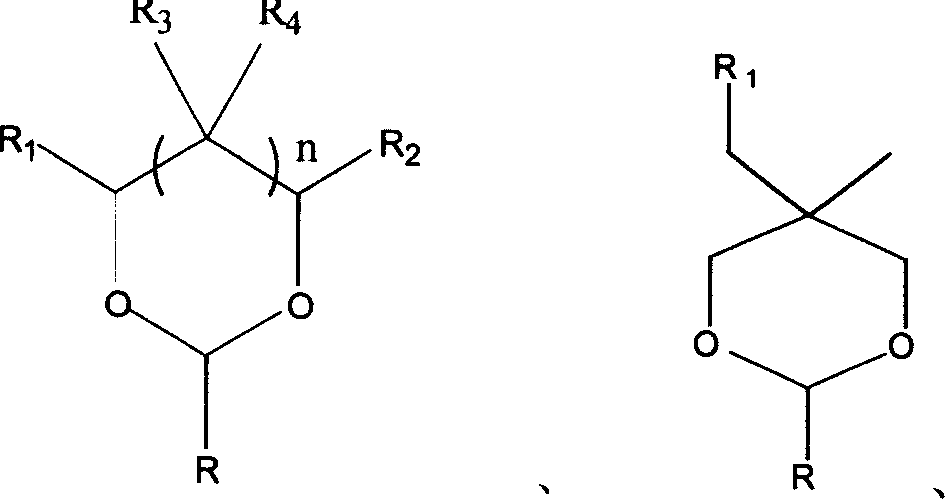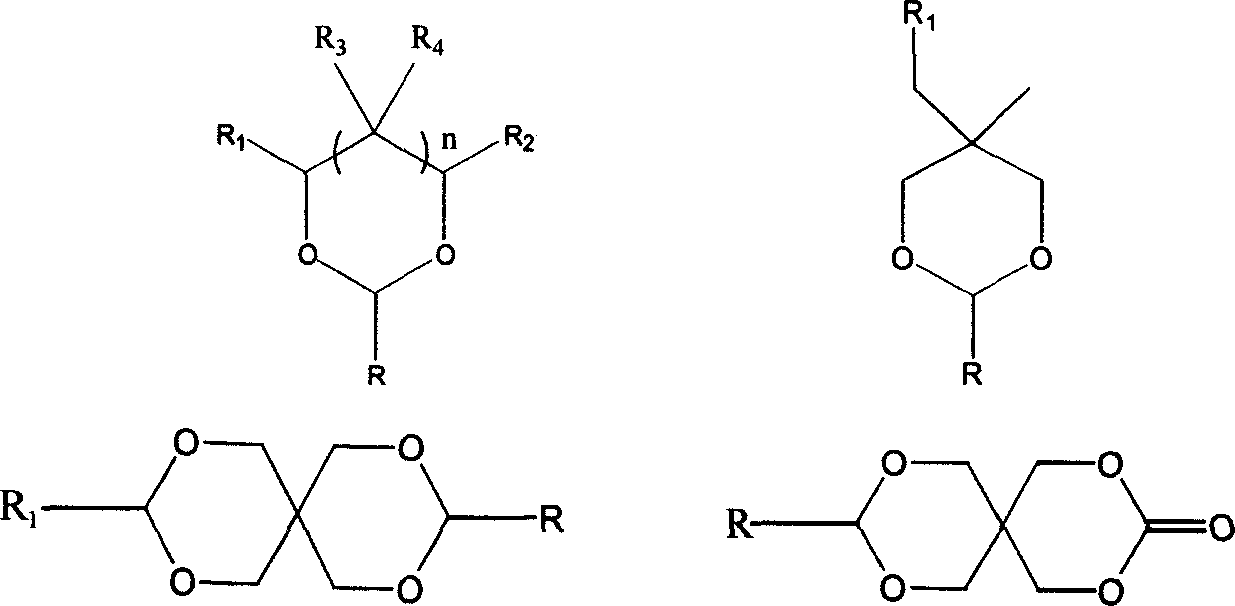Cyclic aldehyde acetal used as initiator aid of dental filling visible light curing filling compounding material
A composite material and co-initiator technology, applied in dental preparations, dentistry, dental prostheses, etc., can solve problems such as human toxicity, achieve low biotoxicity, improve biocompatibility, and reduce biotoxicity
- Summary
- Abstract
- Description
- Claims
- Application Information
AI Technical Summary
Problems solved by technology
Method used
Image
Examples
example 1
[0013] Dissolving 0.7542g photoinitiator CQ in 37.7g TEGDMA, mixed with 113.0g EO-BISGMA (Mn=1700) to prepare EO-BISGMA / TEGDMA proportioning is 75wt%: 25wt%, CQ content is the organic resin system of 0.5wt% 1. Stir fully to make the system mix evenly, and place it in a dark room for subsequent use.
[0014] Weigh 0.08g of glycerin formal into a 25mL beaker, then add 19.8275g of organic resin system I therein, and mix uniformly to obtain an organic resin mixture containing 0.4wt% cyclic acetal. Adding the fumed silica filler AEROSIL OX50 (Germany DEGUSSA company) 1.3426g (volume content is 60% of the mixture total amount) that average particle size is 40 nanometers in this system then, fully stirs it to mix homogeneously, obtains organic resin system and A composite material system with an inorganic filler volume ratio of 40:60. In the dark room, the composite material system was left to stand for 12 hours and then injected into a 8mm (diameter) × 1mm (thickness) polytetrafluo...
example 2
[0016] Dissolve 6.84g CQ in 54.7g TEGDMA, mix with 82.1g BISGMA to prepare BISGMA / TEGDMA ratio is 60wt%: 40wt%, CQ content is 4.7wt% organic resin system II, stir well to make the system mix evenly, place in dark room in spare.
[0017] Weigh 0.5362g of 2-methyl-1,3-dioxolane into a 25mL beaker, then add 10.2013g of organic resin system II to it, and mix evenly to obtain an organic resin mixture containing 5.0wt% cyclic acetal. Adding the fumed silica filler AEROSIL R711 (Germany DEGUSSA company) 0.7906g (volume content is 40% of the mixture total amount) that average particle size is 12 nanometers in this system then, fully stir it and make it mix homogeneously, obtain organic resin system and A composite material system with an inorganic filler volume ratio of 60:40. In the dark room, the composite material system was left to stand for 12 hours and then injected into a 8mm (diameter) × 1mm (thickness) polytetrafluoroethylene template. test. At room temperature and in an a...
example 3
[0019] Dissolve 1.0321g CQ in the TEGDMA of 13.6g, mix with 54.3g UDMA and prepare UDMA / TEGDMA proportioning as 80wt%: 20wt%, CQ content is the organic resin system III of 1.5wt%, fully stirs to make the system mix evenly, place Store in the darkroom.
[0020] Weigh 1.1570g of 2-phenyl-5,5-dimethyl-1,3-dioxane compound in a 25mL beaker, then add 13.0264g of organic resin system III to it, stir well to make the system evenly mixed, An organic resin mixture containing 8.2% by weight of cyclic acetal was obtained. Then in this system, add the barium borosilicate glass (U.S. ESSCHEM company) 8.5356g (volume content is 30% of the mixture total amount) and the fumed silica filler AEROSIL R711 (Germany) with an average particle size of 12 nanometers in the system with an average particle size of 12.5 microns DEGUSSA company) 0.6063 grams (volume content is 40% of the mixture total amount), fully stirred to make it mix evenly, obtain the composite material system that the volume rati...
PUM
 Login to View More
Login to View More Abstract
Description
Claims
Application Information
 Login to View More
Login to View More - R&D
- Intellectual Property
- Life Sciences
- Materials
- Tech Scout
- Unparalleled Data Quality
- Higher Quality Content
- 60% Fewer Hallucinations
Browse by: Latest US Patents, China's latest patents, Technical Efficacy Thesaurus, Application Domain, Technology Topic, Popular Technical Reports.
© 2025 PatSnap. All rights reserved.Legal|Privacy policy|Modern Slavery Act Transparency Statement|Sitemap|About US| Contact US: help@patsnap.com


